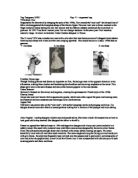A HISTORY OF FASHION (1900-2003)
Since 1900 styles and fashions have changes dramatically. In the 1900's and 1910's changes in lifestyle has an enormous effect on the clothes people wore. Motoring was becoming a fashionable leisure activity and because early cars had no windscreen, doors, or roofs, protective clothing was essential. Tweed and leather coats were worn to keep warm in the winter and in summer ladies wore a dust coat or 'duster'. This was made of linen or silk which is a natural dust repellent.
The first world war was another event which affected fashions in the second decade of the century. Because many women joined the services, such as the Women's Auxiliary Army Corps (WAAC), uniforms were common. Military looking jackets with belts and large side pockets became popular and army colours such as grey and khaki were worn. Many women took over the men's jobs because they were fighting in the war, therefore practical clothing was required. Restrictive fashions such as the hobble skirt were abandoned and jodhpurs, trousers and boiler suits considered suitable for women working on farms or in factories. Women had gained more independence as a result of working during the war and wanted to break free from the constraints of tight skirts and rigid corsets.. V shaped necklines subdued colours and fancy trimmings became popular.
In the 1920's it was as if fashion was reflecting a sense of relief after World War 1. Fashionable women abandoned their tight fitting clothes and cut their hair. Clothes became less feminine and took on masculine attributes. A boyish look was admired and in order to achieve this, bosoms were flattened and waists disappeared. Tweed skirts were often worn. The predominantly male pursuits of motoring and smoking were taken up by many young women. Silk blouses, knitted jumpers and cloche hats were popular and women wore rather mannish clothing because they wanted to be seen as capable, independent women, and not as helpless females dressed in frills and lace. Tailored suits consisting of wool jackets and checked skirts were worn with bow ties and canes. People were shocked at the short skirts that were becoming more popular and expensive silk stockings were worn as legs were now on show.
Since 1900 styles and fashions have changes dramatically. In the 1900's and 1910's changes in lifestyle has an enormous effect on the clothes people wore. Motoring was becoming a fashionable leisure activity and because early cars had no windscreen, doors, or roofs, protective clothing was essential. Tweed and leather coats were worn to keep warm in the winter and in summer ladies wore a dust coat or 'duster'. This was made of linen or silk which is a natural dust repellent.
The first world war was another event which affected fashions in the second decade of the century. Because many women joined the services, such as the Women's Auxiliary Army Corps (WAAC), uniforms were common. Military looking jackets with belts and large side pockets became popular and army colours such as grey and khaki were worn. Many women took over the men's jobs because they were fighting in the war, therefore practical clothing was required. Restrictive fashions such as the hobble skirt were abandoned and jodhpurs, trousers and boiler suits considered suitable for women working on farms or in factories. Women had gained more independence as a result of working during the war and wanted to break free from the constraints of tight skirts and rigid corsets.. V shaped necklines subdued colours and fancy trimmings became popular.
In the 1920's it was as if fashion was reflecting a sense of relief after World War 1. Fashionable women abandoned their tight fitting clothes and cut their hair. Clothes became less feminine and took on masculine attributes. A boyish look was admired and in order to achieve this, bosoms were flattened and waists disappeared. Tweed skirts were often worn. The predominantly male pursuits of motoring and smoking were taken up by many young women. Silk blouses, knitted jumpers and cloche hats were popular and women wore rather mannish clothing because they wanted to be seen as capable, independent women, and not as helpless females dressed in frills and lace. Tailored suits consisting of wool jackets and checked skirts were worn with bow ties and canes. People were shocked at the short skirts that were becoming more popular and expensive silk stockings were worn as legs were now on show.







